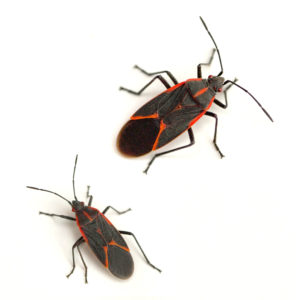Boxelder Bugs
They don’t sting, they don’t transmit disease, and a defensive bite is extremely rare; however, boxelder bugs are still quite the nuisance when they decide to take up residence inside your home. Why is this? Well, their feces can stain light-colored surfaces such as walls, curtains, and furniture, plus an impulsive squash will release an unpleasant odor. Then there’s the fact that most of us just don’t want random bug guests invading our personal space! So let’s explore the world of the boxelder bug and see what we see.
What do they even look like?
An adult boxelder bug is about ½ of an inch long and has three distinctive red stripes located behind the head region and red lines on the wings. They are a slate gray in coloration and the abdomen is also red underneath the wings, as are the eyes. The babies, or nymphs, are very bright red and have a deeper color on the head region.
What do they eat?
You probably won’t be surprised to learn that boxelder bugs eat boxelder trees. There is a distinction in trees, however, as the female boxelder trees are the seed-bearing variety and are the primary food source for this insect. They also reproduce on the female boxelder trees, so this is the primary location and food source. On occasion, a male (non-seed-bearing) tree will become a food source for the bugs, but this is the exception and not the rule. The boxelder bug also eats apple, buckeye, maple, ash, cherry, grape, peach, and plum ornamentals.
Where do they live?
As stated earlier, they reproduce on the female, seed-bearing, boxelder tree. As the summer season comes to an end, the boxelder bug searches for a place to overwinter. They can fly up to two miles to find a suitable home for the cold season. Typically, they prefer tree stumps, underneath debris or rock piles, and drumroll…in our homes such as crevices in walls, doors, and window casings.
What is the behavior of the boxelder?
Late summer and the early part of the fall find large gatherings of nymph and adult boxelder bugs on boxelder tree bark. This immense gathering is followed by the search for an overwintering home. As mentioned, they can fly up to two miles to find the ideal location or simply crawl to a suitable area if it is close enough. This is the point where they are looking for warmth and shelter and may cause the most nuisance for homeowners if the location of choice happens to be the cracks and crevices in your home! Throughout the winter months, they are mostly inactive unless warmer-than-usual temperatures tempt them out of their cozy hideaways. Homeowners most often find them resting on the southern or western sides of their homes, and more often than not, find the insects seeking white or lighter surfaces. If the bugs have chosen your home for overwintering, you might have a number of them appear on your interior walls or curtains on a sunny, winter day.
Depending on the spring weather, the bugs begin to emerge from their winter rest in March and April. Now is the time they are looking for food, and as we have discussed, this is primarily the seed-bearing boxelder tree. For about two weeks, the bugs will focus on feeding, and then mating begins. The eggs are laid in cracks and crevices near the host plants. By mid-July, the new adults begin to lay eggs for the fall generation to begin the life cycle again.
What can I do to prevent boxelder bugs from invading my home?
For the most part, boxelder bugs on the outside of the house are temporary and not a cause for concern. If, however, you want to get rid of the large gatherings, a professional pest control company can help with the process. If the bugs are inside the home, control can be more difficult. Most people find that a vacuum cleaner is the best way to deal with the occasional boxelder bug problem. Remember to clean the vacuum after the process. Also, remember that squashing the bugs can produce a foul smell you may regret causing!
With all pests, the best defense is an effective offense. In the case of the boxelder bug, there are a few steps you can take to keep your home bug-free. First of all, since the female boxelder (seed-bearing) is the favorite food source of this pest, getting rid of these in your yard is a likely deterrent. Eliminating rock piles, and debris such as lumber, stumps, and leaves is a wise step in keeping your yard from becoming an attractive winter home. As far as the home itself, keeping cracks and crevices sealed is recommended to prevent pest entry. Remember to screen your windows and crawl spaces, use weatherstripping around your doors and windows, and otherwise, seal cracks and crevices found in your house. Having ongoing pest control services is a great way to have a professional find potential problems before they become an issue.
If boxelder bugs or any other pest is a nuisance in your home, give us a call at 770-479-1598.
Happy summer and stay cool!
Canton Termite and Pest Control
By: Robin
